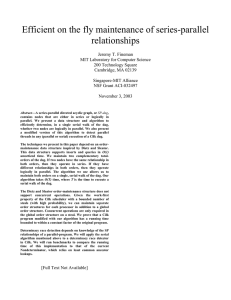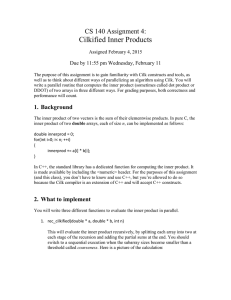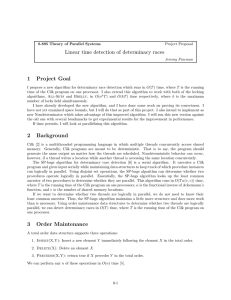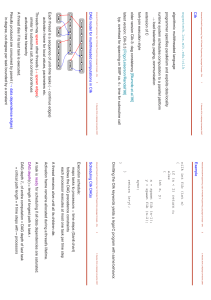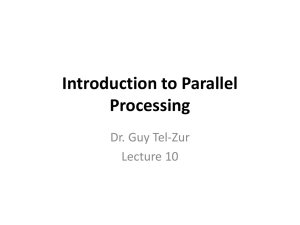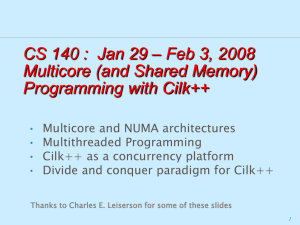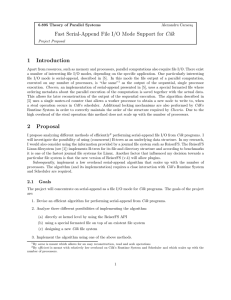– Feb 3, 2010 CS 140 : Jan 27
advertisement
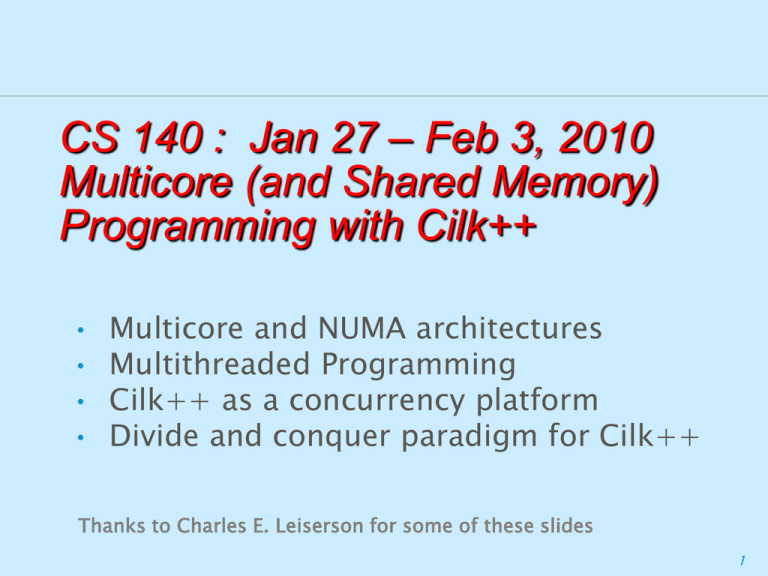
CS 140 : Jan 27 – Feb 3, 2010
Multicore (and Shared Memory)
Programming with Cilk++
•
•
•
•
Multicore and NUMA architectures
Multithreaded Programming
Cilk++ as a concurrency platform
Divide and conquer paradigm for Cilk++
Thanks to Charles E. Leiserson for some of these slides
1
Multicore Architecture
Memory
I/O
Network
$
$
core
core
…
$
core
Chip Multiprocessor (CMP)
2
cc-NUMA Architectures
AMD 8-way Opteron Server (neumann@cs.ucsb.edu)
Memory
bank local to
a processor
A processor
(CMP) with
2/4 cores
3
cc-NUMA Architectures
∙
∙
∙
∙
No Front Side Bus
Integrated memory controller
On-die interconnect among CMPs
Main memory is physically distributed
among CMPs (i.e. each piece of memory
has an affinity to a CMP)
∙ NUMA: Non-uniform memory access.
For multi-socket servers only
Your desktop is safe (well, for now at least)
Triton nodes are also NUMA !
4
Desktop Multicores Today
This is your AMD Shangai or Intel Core i7 (Nehalem) !
On-die
interconnect
Private
cache: Cache
coherence is
required
5
Multithreaded Programming
∙ A thread of execution is a fork of a
computer program into two or more
concurrently running tasks.
∙ POSIX Threads (Pthreads) is a set of
threading interfaces developed by the IEEE
∙ Assembly of shared memory programming
∙ Programmer has to manually:
Create and terminating threads
Wait for threads to complete
Manage the interaction between threads using
mutexes, condition variables, etc.
6
Concurrency Platforms
Ahh!
Sigh!
• Programming directly on PThreads is
painful and error-prone.
• With PThreads, you either sacrifice memory
usage or load-balance among processors
• A concurrency platform provides linguistic
support and handles load balancing.
• Examples:
• Threading Building Blocks (TBB)
• OpenMP
• Cilk++
7
Cilk vs. PThreads
How will the following code execute in
PThreads? In Cilk?
for (i=1; i<1000000000; i++) {
spawn-or-fork foo(i);
}
sync-or-join;
What if foo contains code that waits (e.g., spins) on
a variable being set by another instance of foo?
This different is a liveness property:
∙ Cilk threads are spawned lazily, “may” parallelism
∙ PThreads are spawned eagerly, “must” parallelism
8
Cilk vs. OpenMP
∙ Cilk++ guarantees space bounds. On P
processors, Cilk++ uses no more than P
times the stack space of a serial
execution.
∙ Cilk++ has serial semantics.
∙ Cilk++ has a solution for global variables
(a construct called "hyperobjects")
∙ Cilk++ has nested parallelism that works
and provides guaranteed speed-up.
∙ Cilk++ has a race detector for debugging
and software release.
9
Great, how do we program it?
∙ Cilk++ is a faithful extension of C++
∙ Programmer implement algorithms
mostly in the divide-and-conquer (DAC)
paradigm. Two hints to the compiler:
cilk_spawn: the following function can run in
parallel with the caller.
cilk_sync: all spawned children must return
before program execution can continue
∙ Third keyword for programmer
convenience only (compiler converts it to
spawns/syncs under the covers)
cilk_for
10
Nested Parallelism
Example: Quicksort
The named child
function may execute
in parallel with the
parent caller.
template <typename T>
void qsort(T begin, T end) {
if (begin != end) {
T middle = partition(
begin,
end,
bind2nd( less<typename iterator_traits<T>::value_type>(),
*begin )
);
cilk_spawn qsort(begin, middle);
qsort(max(begin + 1, middle), end);
cilk_sync;
}
}
Control cannot pass this
point until all spawned
children have returned.
11
Cilk++ Loops
Example: Matrix transpose
cilk_for (int i=1; i<n; ++i) {
cilk_for (int j=0; j<i; ++j) {
B[i][j] = A[j][i];
}
}
∙ A cilk_for loop’s iterations execute in
parallel.
∙ The index must be declared in the loop
initializer.
∙ The end condition is evaluated exactly
once at the beginning of the loop.
∙ Loop increments should be a const value
12
Serial Correctness
The serialization is the
int fib (int n) {
if (n<2) return (n);
code with
the Cilk++
Cilk++
else {
int x,y;
Compiler
keywords
replaced by
x = cilk_spawn fib(n-1);
y = fib(n-2);
Conventional
cilk_sync;
null
or
C++
keywords.
Compiler
return (x+y);
}
}
Cilk++ source
int fib (int n) {
if (n<2) return (n);
else {
int x,y;
x = fib(n-1);
y = fib(n-2);
return (x+y);
}
Serialization
}
Serial correctness can
Conventional
be debugged
and Tests
Regression
verified by running the
multithreaded
code on a
Reliable Singlesingle processor.
Threaded Code
Linker
Binary
Cilk++ Runtime
Library
13
Serialization
How to seamlessly switch between serial
c++ and parallel cilk++ programs?
#ifdef CILKPAR
#include <cilk.h>
#else
#define cilk_for for
#define cilk_main main
#define cilk_spawn
#define cilk_sync
#endif
Add to the
beginning of
your program
Compile !
cilk++ -DCILKPAR –O2 –o parallel.exe main.cpp
g++ –O2 –o serial.exe main.cpp
14
Parallel Correctness
int fib (int n) {
if (n<2) return (n);
else {
int x,y;
x = cilk_spawn fib(n-1);
y = fib(n-2);
cilk_sync;
return (x+y);
}
}
Cilk++ source
Cilk++
Compiler
Conventional
Compiler
Linker
Binary
Parallel correctness can be debugged
and verified with the Cilkscreen race
detector, which guarantees to find
inconsistencies with the serial code
quickly.
Cilkscreen
Race Detector
Parallel
Regression Tests
Reliable MultiThreaded Code
15
Race Bugs
Definition. A determinacy race occurs when
two logically parallel instructions access the
same memory location and at least one of
the instructions performs a write.
Example
A
B
C
D
int x = 0;
cilk_for(int i=0, i<2, ++i) {
x++;
}
assert(x == 2);
A
int x = 0;
B
x++;
x++;
C
assert(x == 2);
D
Dependency Graph
16
Race Bugs
Definition. A determinacy race occurs when
two logically parallel instructions access the
same memory location and at least one of
the instructions performs a write.
1
x = 0;
A
int x = 0;
B
x++;
x++;
assert(x == 2);
C
2
r1 = x;
4
r2 = x;
3
r1++;
5
r2++;
7
x = r1;
6
x = r2;
D
8
assert(x == 2);
17
Types of Races
Suppose that instruction A and instruction B
both access a location x, and suppose that
A∥B (A is parallel to B).
A
read
read
write
write
B
read
write
read
write
Race Type
none
read race
read race
write race
Two sections of code are independent if they
have no determinacy races between them.
18
Avoiding Races
All the iterations of a cilk_for should be
independent.
Between a cilk_spawn and the corresponding
cilk_sync, the code of the spawned child should
be independent of the code of the parent, including
code executed by additional spawned or called
children.
Ex.
cilk_spawn qsort(begin, middle);
qsort(max(begin + 1, middle), end);
cilk_sync;
Note: The arguments to a spawned function are
evaluated in the parent before the spawn occurs.
19
Cilkscreen
∙ Cilkscreen runs off the binary executable:
Compile your program with the –fcilkscreen
option to include debugging information.
Go to the directory with your executable and
execute cilkscreen your_program [options]
Cilkscreen prints information about any races it
detects.
∙ For a given input, Cilkscreen mathematically
guarantees to localize a race if there exists a
parallel execution that could produce results
different from the serial execution.
∙ It runs about 20 times slower than real-time.
20
Complexity Measures
TP = execution time on P processors
T1 = work
T∞ = span*
WORK LAW
∙TP ≥T1/P
SPAN LAW
∙TP ≥ T∞
*Also called critical-path length
or computational depth.
21
Series Composition
A
B
Work: T1(A∪B) = T1(A) + T1(B)
Span: T∞(A∪B) = T∞(A) +T∞(B)
22
Parallel Composition
A
B
Work: T1(A∪B) = T1(A) + T1(B)
Span: T∞(A∪B) = max{T∞(A), T∞(B)}
23
Speedup
Def. T1/TP = speedup on P processors.
If T1/TP = (P), we have linear speedup,
= P, we have perfect linear speedup,
> P, we have superlinear speedup,
which is not possible in this performance
model, because of the Work Law TP ≥ T1/P.
24
Parallelism
Because the Span Law dictates
that TP ≥ T∞, the maximum
possible speedup given T1
and T∞ is
T1/T∞ = parallelism
= the average
amount of work
per step along
the span.
25
Three Tips on Parallelism
1. Minimize the span to maximize parallelism. Try
to generate 10 times more parallelism than
processors for near-perfect linear speedup.
2. If you have plenty of parallelism, try to trade
some if it off for reduced work overheads.
3. Use divide-and-conquer recursion or parallel
loops rather than spawning one small thing off
after another.
Do this:
cilk_for (int i=0; i<n; ++i) {
foo(i);
}
Not this:
for (int i=0; i<n; ++i) {
cilk_spawn foo(i);
}
cilk_sync;
26
Three Tips on Overheads
1. Make sure that work/#spawns is not too small.
• Coarsen by using function calls and inlining
near the leaves of recursion rather than
spawning.
2. Parallelize outer loops if you can, not inner
loops. If you must parallelize an inner loop,
coarsen it, but not too much.
• 500 iterations should be plenty coarse for
even the most meager loop.
• Fewer iterations should suffice for “fatter”
loops.
3. Use reducers only in sufficiently fat loops.
27
Sorting
∙ Sorting is possibly the most frequently
executed operation in computing!
∙ Quicksort is the fastest sorting algorithm
in practice with an average running time
of O(N log N), (but O(N2) worst case
performance)
∙ Mergesort has worst case performance of
O(N log N) for sorting N elements
∙ Both based on the recursive divide-andconquer paradigm
28
QUICKSORT
∙ Basic Quicksort sorting an array S works
as follows:
If the number of elements in S is 0 or 1, then
return.
Pick any element v in S. Call this pivot.
Partition the set S-{v} into two disjoint
groups:
S1 = {x S-{v} | x v}
♦ S2 = {x S-{v} | x v}
♦
Return quicksort(S1) followed by v followed by
quicksort(S2)
29
QUICKSORT
13
32
45
34
21
14
56
31
78
Select Pivot
13
32
45
21
34
14
31
56
78
30
QUICKSORT
13
32
45
34
21
14
31
56
78
Partition around Pivot
13
14
31
32
21
34
56
45
78
31
QUICKSORT
13
31
14
21
34
32
56
45
78
Quicksort recursively
13
13
14
14
21
21
31 32
31 32
34
34
45
45
56
56
78
78
32
